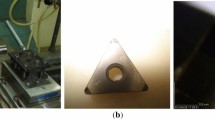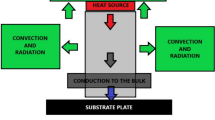Abstract
In this work, the in-die heating (IDH) tailored hot stamping (THS) process is considered, in which the forming tool is partitioned into zones that are either cooled or heated. Four configurations of THS rails were formed: a non-tailored configuration using conventional room temperature tooling and three tailored configurations in which one-half of the rail was formed in tooling that was heated at different temperatures (in the range 400–700 °C). Micro-hardness measurements confirmed that THS can be used to form an axial crush member that contains tailored properties along its length. The as-formed parts exhibited a Vickers hardness of 430–484 HV in zones formed in cooled tooling, 235–280 HV in zones formed in tooling that was heated to 400 °C and 190–215 HV in zones that were formed when the die set was heated to 700 °C. Numerical models of the THS process were developed using the Åkerström material model in LS-Dyna. As part of the modelling, the activation energies for each phase were calibrated using an LS-OPT routine. The resulting hardness predictions were compared with experimental data to assess the accuracy of the LS-OPT routine. The predicted hardness distributions in the components were quite accurate (usually within 10%, but as high as 16% in some cases).



















Similar content being viewed by others
References
Karbasian H (2010) Tekkaya a. E. A review on hot stamping. J Mater Process Technol 210:2103–2118. doi:10.1016/j.jmatprotec.2010.07.019
Erhardt R, Böke J (2008) Industrial application of hot forming press simulation. 1st Int. Conf. hot sheet Met. Form., Kassel, Germany, p. 83–8
Merklein M, Wieland M, Lechner M, Bruschi S, Ghiotti A (2015) Hot stamping of boron steel sheets with tailored properties: a review. J Mater Process Technol. doi:10.1016/j.jmatprotec.2015.09.023
Banik J, Lenze FJ, Sikora S, Laurenz R (2011) Tailored properties - a pivotal question for hot forming. 2nd Int. Conf. Hot Sheet Met. Form., Lulea, Sweden, p. 15–7
George R (2012) Bardelcik a., Worswick MJ. Hot forming of boron steels using heated and cooled tooling for tailored properties. J Mater Process Technol 212:2386–2399. doi:10.1016/j.jmatprotec.2012.06.028
Berglund D, Amundsson K, Hellgren L (2009) Hot stamped components with soft zones-simulation and validation of material properties and product performance. Steel Grips
Eller TK, Greve L, Andres MT, Medricky M (2014) Hatscher a., Meinders VT, et al. plasticity and fracture modeling of quench-hardenable boron steel with tailored properties. J Mater Process Technol 214:1211–1227. doi:10.1016/j.jmatprotec.2013.12.015
Omer K, Bardelcik A, George R, Detwiler D, Adam N, Worswick M (2014) Development of a hot stamped axial crush member with tailored properties. Proc. Int. Deep Draw Res. Gr. Conf., Paris, France
Li MV, Niebuhr DV, Meekisho LL, Atteridge DG (1998) A computational model for the prediction of steel hardenability. Metall Mater Trans B Process Metall Mater Process Sci 29:661–672. doi:10.1007/s11663-998-0101-3
Åkerström P, Bergman G, Oldenburg M (2007) Numerical implementation of a constitutive model for simulation of hot stamping. Model Simul Mater Sci Eng 15:105–119. doi:10.1088/0965-0393/15/2/007
Olsson T. (2009) An LS-DYNA material model for simulations of hot stamping processes of ultra high strength steels. ERAB
Hochholdinger B, Lorenz D, Erhart T, Schill M (2013) Prediction of phase fractions and vickers hardness in hot stamping processes with an advanced material model in LS-DYNA. LS-Dyna Anwenderforum 2013, Filderstadt, Germany
Shapiro AB (2008) Using LS-DYNA to model hot sheet metal stamping. 1st Int. Conf. Hot Sheet Met. Form. High-Performance Steel, Kassel, Germany
Caron EJFR, Daun KJ, Wells MA (2014) Experimental heat transfer coefficient measurements during hot forming die quenching of boron steel at high temperatures. Int J Heat Mass Transf 71:396–404. doi:10.1016/j.ijheatmasstransfer.2013.12.039
George R (2011) Hot forming of boron steels with tailored mechanical properties: experiments and numerical simulations. University of Waterloo
Maynier P, Dollet J, Bastien P (1978) Hardenability concepts with applications to steels. Hardenability concepts with Appl. To steels. AIME, New York City, pp 518–544
Bhadeshia HKDH (1992) Bainite in Steels. London, U.K, The Institute of Materials
Honeycombe RWK, Bhardeshia H (1981) Steels - microstructure and properties. Edvard Arnold, Burlington, MA, U.S.A
Barcellona A, Palmeri D (2009) Effect of plastic hot deformation on the hardness and continuous cooling transformations of 22MnB5 microalloyed boron steel. Metall Mater Trans A Phys Metall Mater Sci 40:1160–1174. doi:10.1007/s11661-009-9790-8
Bardelcik A, Worswick MJ, Wells MA (2014) The influence of martensite, bainite and ferrite on the as-quenched constitutive response of simultaneously quenched and deformed boron steel - experiments and model. Mater Des 55:509–525. doi:10.1016/j.matdes.2013.10.014
Beer FP, Johnstron ER, DeWolf JT, Mazurek DF (2012) Mechanics of materials, 6th edn. McGraw Hill, New York City, N.Y
Touloukian YS (1970) Thermophysical properties of matter. IFI/Plenum
ZRCI (2005) Refractory composites. REFRACTORY BOARD TYPES ZIRCAL-18, ZIRCAL-45 AND ZIRCAL-95
Arnoult WJ, McLellan RB (1975) Variation of the Young’s modulus of austenite with carbon concentration. Acta Metall 23:51–56. doi:10.1016/0001-6160(75)90068-1
Farraro R, Mclellan RB (1977) Temperature dependence of the Young’s modulus and shear modulus of pure nickel, platinum, and molybdenum. Metall Trans A 8:1563–1565. doi:10.1007/BF02644859
Åkerström P. Modelling and simulation of hot stamping 2006.
Livermore Software Technology Corporation (LSTC) (2014) Keyword User ’ S Manual Volume II. vol. II. Livermore, CA, USA
Bardelcik A, Salisbury CP, Winkler S, Wells MA, Worswick MJ (2010) Effect of cooling rate on the high strain rate properties of boron steel. Int J Impact Eng 37:694–702. doi:10.1016/j.ijimpeng.2009.05.009
Author information
Authors and Affiliations
Corresponding author
Ethics declarations
Funding
This study was funded by Honda R&D Americas, Promatek Research Center (Cosma International), ArcelorMittal, Automotive Partnership Canada, the Natural Sciences and Engineering Research Council, the Ontario Research Fund and the Canada Research Chair Secretariat. Support for this research from all of these parties is gratefully acknowledged.
Conflict of interest
The authors declare that they have no conflict of interest.
Rights and permissions
About this article
Cite this article
Omer, K., George, R., Bardelcik, A. et al. Development of a hot stamped channel section with axially tailored properties – experiments and models. Int J Mater Form 11, 149–164 (2018). https://doi.org/10.1007/s12289-017-1338-7
Received:
Accepted:
Published:
Issue Date:
DOI: https://doi.org/10.1007/s12289-017-1338-7




